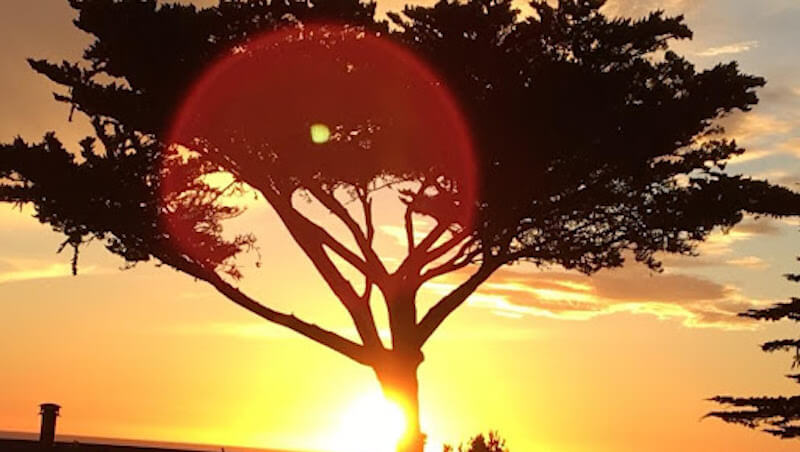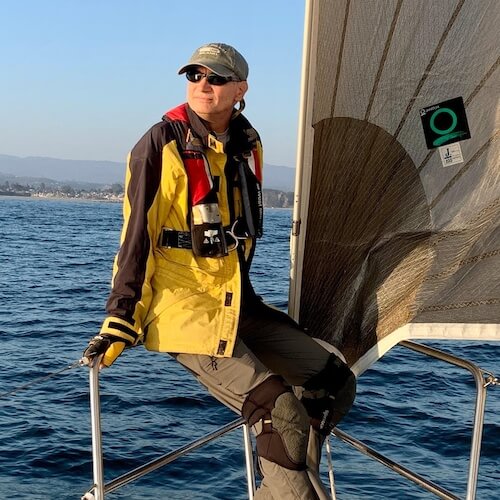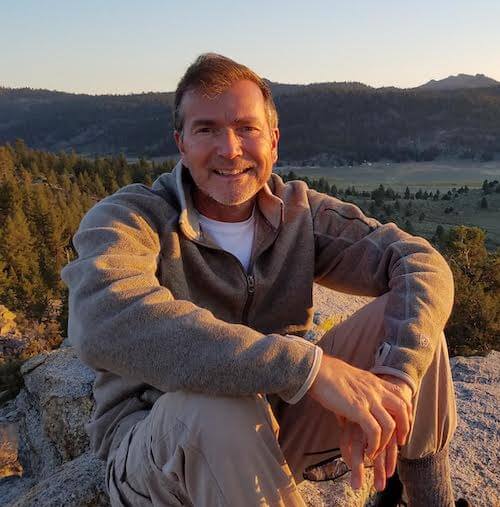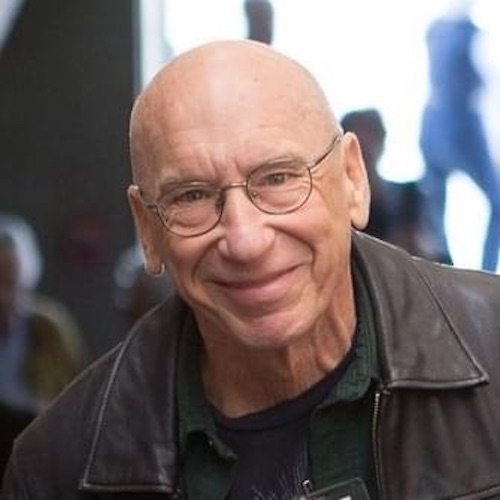
Sravana Borkataky-Varma, Esalen Board Member and Harvard Divinity School Scholar, is a practitioner of Śākta Tantra, informed by knowledge of Vajrayāna (Buddhist Tantra), which also includes engagement with the maṇḍala, which takes different forms (rūpa). Her practice started when she was eight years old in India; eventually, she earned a Ph.D. in the United States.
“In maṇḍala practice, experiences arise and dissolve, just as thoughts evolve and devolve. And these maṇḍalas need not be restricted to images but can be, and dare I say should be, extended to the geography of the place we live,” said Borkataky-Varma. “They include nature, people, animals, and even mundane buildings.”
A maṇḍala (Sanskrit for “circle” or “discoid object,”) is a geometric design that holds a great deal of symbolism in Hindu and Buddhist cultures. A majority are depicted as spheres, but Borkataky-Varma encourages her students to build their own, in their own way, “allowing for spontaneous creation and dismantling,” she explained, “…the shape of a spiral, occasionally with sharp edges, and sometimes with no boundaries whatsoever” — an experience of macrocosm revealed through the mandala itself.
In advance of her upcoming workshop, Borkataky-Varma shares her insight into The Esalen Mandala — a visual, physical, and boundless story told through sacred geometry and Tantra in the midst of cosmic nature.
By Sravana Borkataky-Varma
It is 2015, spring. Crisp air, bright sunshine. Children with sun-kissed hair play on the lush green lawns. The sound of the ocean. Fragrances mingle from the flower and fruit trees.
All this welcomes me to the Esalen Institute.
The last seven years, I visited Esalen several times, to my great fortune. On each occasion, I heard stories about the transformations people experience there. I was also transformed. People feel connection and wholeness. I started wondering what in these grounds brings such profound experiences.
Esalen is a maṇḍala: a mystic representation that is also a truth, a cosmology that is living, breathing, ever-changing yet constant. I have come to see this. Maṇḍalas are complex, their meaning and use open to varied approaches.
In Buddhist Tantra (Vajrayāna), a maṇḍala is a sacred diagram. Practitioners ritualistically view and deploy a maṇḍala to transcend their microcosm, to actively engage the macrocosm, on the vertical plane, so to speak. Some consider that macrocosm to be the cosmos.
The maṇḍala and cosmos are the perfected realm of the deity, attuned to the microcosmic world of practitioners’ psychological states. In other words, a maṇḍala practice transforms and translocates the cosmos to be centered on the practitioner. This power of transportability confers empowerment over reality through insight. Hence, a maṇḍala can be a type of cosmogram.
Hindu Tantra uses yantras (symbolic figures, also contraptions). A yantra, in comparison to a maṇḍala, is made of simpler linear diagrams of concentric configurations. The center (bindu or drop) is the most important, for from it the full yantra emanates. The Kulārṇava Tantra (1000–1400 CE) establishes the importance of yantra in ritual space: “as the body to the soul, oil to the lamp, a yantra is to the deity.” (Avalon 1965, 154). The most popular yantra, also the most globally transmitted, is the Śrīyantra or the Śrīcakra, born from the Śrīvidyā school of Hindu Śākta Tantra, so-called goddess Tantra.
The end goal for yantra is the same as maṇḍala. Practitioners realize their essential self and the universe to be empty of inherent existence, a mere construction, māyā, illusion. Realization of the gnostic truth.
My maṇḍala is often dynamic, emblematic of creation and destruction. It is a space where binaries that govern our everyday lives dissolve. With each successful dissolution (even if it is fleeting) in me, the practice cultivates compassion, kindness, inclusiveness, and a degree of ineffable luminosity. That said, I am a flawed being, and I do not claim to have achieved any form of perfection.
Esalen Institute's tantric roots are laid out in Jeffrey Kripal's Esalen (2008). With the 1960s backdrop — including the sexual revolution, psychedelic revelation, and the American counterculture — Esalen provided an alternative to an alternative: "the religion of no religion promises a sexual orientation of no sexual orientation, a gender of no gender, that is, a polyamorous eroticism, a culture 'beyond gender' that refuses to be dogmatic about desire." (Kripal 2008, 462-63). All this is true.
But, over the last seven years, I have wondered if this long and rich history was simply a product of Michael Murphy and Richard Price's vision, plus the sixties, plus the longings of a culture wounded by the Vietnam war and racial segregation. Or was there something more embedded in the land, in the hot springs, in the air? That wondering began my journey looking at the land as a geographical maṇḍala.
I intentionally walk the land after soaking in the healing waters. I consciously stop to let the expanse of the ocean rest in me. I smell the flowers in the garden while simultaneously watching monarch butterflies. I dip my toes in the cold water of the creek. All the while, I speak to the universe in the nook tucked between the Murphy house and the Price house, and creative magic is revealed itself by the art barn, and, finally, I meditate in the serpent corner. The Esalen maṇḍala shines forth.
Tantric cosmology emphasizes dynamic relationships between places and people. Nature and sentient beings are inextricably linked. Transformation emerges in the co-creative space of a “cosmic dance.” Being on the land consciously and unconsciously allows a maṇḍala to be constructed — the here and now collapses.
Sitting under a star canopy, the ocean crashing against the mountain, the separation between the local and the cosmic dissolves, simultaneously transforming and translocating the geographical land into a cosmos centered on an individual being. The splendor of the manifested universe is expressed in its visual metaphysics, felt in the cells of our physical bodies, runs through subtle channels to generate experiences of the macrocosm. A deep realization of the incipient unity of male and female principles ensues. Some people even grasp a fleeting glimpse of the purified vision of reality.
It is for good reason that so many return year after year.

“Remembering to be as self compassionate as I can and praying to the divine that we're all a part of.”
–Aaron
“Prayer, reading, meditation, walking.”
–Karen
“Erratically — which is an ongoing stream of practice to find peace.”
–Charles
“Try on a daily basis to be kind to myself and to realize that making mistakes is a part of the human condition. Learning from our mistakes is a journey. But it starts with compassion and caring. First for oneself.”
–Steve
“Physically: aerobic exercise, volleyball, ice hockey, cycling, sailing. Emotionally: unfortunately I have to work to ‘not care’ about people or situations which may end painfully. Along the lines of ‘attachment is the source of suffering’, so best to avoid it or limit its scope. Sad though because it could also be the source of great joy. Is it worth the risk?“
–Rainer


“It's time for my heart to be nurtured on one level yet contained on another. To go easy on me and to allow my feelings to be validated, not judged harshly. On the other hand, to let the heart rule with equanimity and not lead the mind and body around like a master.”
–Suzanne
“I spend time thinking of everything I am grateful for, and I try to develop my ability to express compassion for myself and others without reservation. I take time to do the things I need to do to keep myself healthy and happy. This includes taking experiential workshops, fostering relationships, and participating within groups which have a similar interest to become a more compassionate and fulfilled being.“
–Peter


“Self-forgiveness for my own judgments. And oh yeah, coming to Esalen.”
–David B.
“Hmm, this is a tough one! I guess I take care of my heart through fostering relationships with people I feel connected to. Spending quality time with them (whether we're on the phone, through messages/letters, on Zoom, or in-person). Being there for them, listening to them, sharing what's going on with me, my struggles and my successes... like we do in the Esalen weekly Friends of Esalen Zoom sessions!”
–Lori

“I remind myself in many ways of the fact that " Love is all there is!" LOVE is the prize and this one precious life is the stage we get to learn our lessons. I get out into nature, hike, camp, river kayak, fly fish, garden, I create, I dance (not enough!), and I remain grateful for each day, each breath, each moment. Being in the moment, awake, and remembering the gift of life and my feeling of gratitude for all of creation.”
–Steven
“My physical heart by limiting stress and eating a heart-healthy diet. My emotional heart by staying in love with the world and by knowing that all disappointment and loss will pass.“
–David Z.
Today, September 29, is World Heart Day. Strike up a conversation with your own heart and as you feel comfortable, encourage others to do the same. As part of our own transformations and self-care, we sometimes ask for others to illuminate and enliven our hearts or speak our love language.
What if we could do this for ourselves too, even if just for today… or to start a heart practice, forever?
Sravana Borkataky-Varma and Keith Cantu’s workshop — Tantra: The Body and The Release, an Esalen Signature Series, Part 2: Wheels and Breath: A Tantric Body — is April 15-18, 2022.

Sravana Borkataky-Varma, Esalen Board Member and Harvard Divinity School Scholar, is a practitioner of Śākta Tantra, informed by knowledge of Vajrayāna (Buddhist Tantra), which also includes engagement with the maṇḍala, which takes different forms (rūpa). Her practice started when she was eight years old in India; eventually, she earned a Ph.D. in the United States.
“In maṇḍala practice, experiences arise and dissolve, just as thoughts evolve and devolve. And these maṇḍalas need not be restricted to images but can be, and dare I say should be, extended to the geography of the place we live,” said Borkataky-Varma. “They include nature, people, animals, and even mundane buildings.”
A maṇḍala (Sanskrit for “circle” or “discoid object,”) is a geometric design that holds a great deal of symbolism in Hindu and Buddhist cultures. A majority are depicted as spheres, but Borkataky-Varma encourages her students to build their own, in their own way, “allowing for spontaneous creation and dismantling,” she explained, “…the shape of a spiral, occasionally with sharp edges, and sometimes with no boundaries whatsoever” — an experience of macrocosm revealed through the mandala itself.
In advance of her upcoming workshop, Borkataky-Varma shares her insight into The Esalen Mandala — a visual, physical, and boundless story told through sacred geometry and Tantra in the midst of cosmic nature.
By Sravana Borkataky-Varma
It is 2015, spring. Crisp air, bright sunshine. Children with sun-kissed hair play on the lush green lawns. The sound of the ocean. Fragrances mingle from the flower and fruit trees.
All this welcomes me to the Esalen Institute.
The last seven years, I visited Esalen several times, to my great fortune. On each occasion, I heard stories about the transformations people experience there. I was also transformed. People feel connection and wholeness. I started wondering what in these grounds brings such profound experiences.
Esalen is a maṇḍala: a mystic representation that is also a truth, a cosmology that is living, breathing, ever-changing yet constant. I have come to see this. Maṇḍalas are complex, their meaning and use open to varied approaches.
In Buddhist Tantra (Vajrayāna), a maṇḍala is a sacred diagram. Practitioners ritualistically view and deploy a maṇḍala to transcend their microcosm, to actively engage the macrocosm, on the vertical plane, so to speak. Some consider that macrocosm to be the cosmos.
The maṇḍala and cosmos are the perfected realm of the deity, attuned to the microcosmic world of practitioners’ psychological states. In other words, a maṇḍala practice transforms and translocates the cosmos to be centered on the practitioner. This power of transportability confers empowerment over reality through insight. Hence, a maṇḍala can be a type of cosmogram.
Hindu Tantra uses yantras (symbolic figures, also contraptions). A yantra, in comparison to a maṇḍala, is made of simpler linear diagrams of concentric configurations. The center (bindu or drop) is the most important, for from it the full yantra emanates. The Kulārṇava Tantra (1000–1400 CE) establishes the importance of yantra in ritual space: “as the body to the soul, oil to the lamp, a yantra is to the deity.” (Avalon 1965, 154). The most popular yantra, also the most globally transmitted, is the Śrīyantra or the Śrīcakra, born from the Śrīvidyā school of Hindu Śākta Tantra, so-called goddess Tantra.
The end goal for yantra is the same as maṇḍala. Practitioners realize their essential self and the universe to be empty of inherent existence, a mere construction, māyā, illusion. Realization of the gnostic truth.
My maṇḍala is often dynamic, emblematic of creation and destruction. It is a space where binaries that govern our everyday lives dissolve. With each successful dissolution (even if it is fleeting) in me, the practice cultivates compassion, kindness, inclusiveness, and a degree of ineffable luminosity. That said, I am a flawed being, and I do not claim to have achieved any form of perfection.
Esalen Institute's tantric roots are laid out in Jeffrey Kripal's Esalen (2008). With the 1960s backdrop — including the sexual revolution, psychedelic revelation, and the American counterculture — Esalen provided an alternative to an alternative: "the religion of no religion promises a sexual orientation of no sexual orientation, a gender of no gender, that is, a polyamorous eroticism, a culture 'beyond gender' that refuses to be dogmatic about desire." (Kripal 2008, 462-63). All this is true.
But, over the last seven years, I have wondered if this long and rich history was simply a product of Michael Murphy and Richard Price's vision, plus the sixties, plus the longings of a culture wounded by the Vietnam war and racial segregation. Or was there something more embedded in the land, in the hot springs, in the air? That wondering began my journey looking at the land as a geographical maṇḍala.
I intentionally walk the land after soaking in the healing waters. I consciously stop to let the expanse of the ocean rest in me. I smell the flowers in the garden while simultaneously watching monarch butterflies. I dip my toes in the cold water of the creek. All the while, I speak to the universe in the nook tucked between the Murphy house and the Price house, and creative magic is revealed itself by the art barn, and, finally, I meditate in the serpent corner. The Esalen maṇḍala shines forth.
Tantric cosmology emphasizes dynamic relationships between places and people. Nature and sentient beings are inextricably linked. Transformation emerges in the co-creative space of a “cosmic dance.” Being on the land consciously and unconsciously allows a maṇḍala to be constructed — the here and now collapses.
Sitting under a star canopy, the ocean crashing against the mountain, the separation between the local and the cosmic dissolves, simultaneously transforming and translocating the geographical land into a cosmos centered on an individual being. The splendor of the manifested universe is expressed in its visual metaphysics, felt in the cells of our physical bodies, runs through subtle channels to generate experiences of the macrocosm. A deep realization of the incipient unity of male and female principles ensues. Some people even grasp a fleeting glimpse of the purified vision of reality.
It is for good reason that so many return year after year.

“Remembering to be as self compassionate as I can and praying to the divine that we're all a part of.”
–Aaron
“Prayer, reading, meditation, walking.”
–Karen
“Erratically — which is an ongoing stream of practice to find peace.”
–Charles
“Try on a daily basis to be kind to myself and to realize that making mistakes is a part of the human condition. Learning from our mistakes is a journey. But it starts with compassion and caring. First for oneself.”
–Steve
“Physically: aerobic exercise, volleyball, ice hockey, cycling, sailing. Emotionally: unfortunately I have to work to ‘not care’ about people or situations which may end painfully. Along the lines of ‘attachment is the source of suffering’, so best to avoid it or limit its scope. Sad though because it could also be the source of great joy. Is it worth the risk?“
–Rainer


“It's time for my heart to be nurtured on one level yet contained on another. To go easy on me and to allow my feelings to be validated, not judged harshly. On the other hand, to let the heart rule with equanimity and not lead the mind and body around like a master.”
–Suzanne
“I spend time thinking of everything I am grateful for, and I try to develop my ability to express compassion for myself and others without reservation. I take time to do the things I need to do to keep myself healthy and happy. This includes taking experiential workshops, fostering relationships, and participating within groups which have a similar interest to become a more compassionate and fulfilled being.“
–Peter


“Self-forgiveness for my own judgments. And oh yeah, coming to Esalen.”
–David B.
“Hmm, this is a tough one! I guess I take care of my heart through fostering relationships with people I feel connected to. Spending quality time with them (whether we're on the phone, through messages/letters, on Zoom, or in-person). Being there for them, listening to them, sharing what's going on with me, my struggles and my successes... like we do in the Esalen weekly Friends of Esalen Zoom sessions!”
–Lori

“I remind myself in many ways of the fact that " Love is all there is!" LOVE is the prize and this one precious life is the stage we get to learn our lessons. I get out into nature, hike, camp, river kayak, fly fish, garden, I create, I dance (not enough!), and I remain grateful for each day, each breath, each moment. Being in the moment, awake, and remembering the gift of life and my feeling of gratitude for all of creation.”
–Steven
“My physical heart by limiting stress and eating a heart-healthy diet. My emotional heart by staying in love with the world and by knowing that all disappointment and loss will pass.“
–David Z.
Today, September 29, is World Heart Day. Strike up a conversation with your own heart and as you feel comfortable, encourage others to do the same. As part of our own transformations and self-care, we sometimes ask for others to illuminate and enliven our hearts or speak our love language.
What if we could do this for ourselves too, even if just for today… or to start a heart practice, forever?
Sravana Borkataky-Varma and Keith Cantu’s workshop — Tantra: The Body and The Release, an Esalen Signature Series, Part 2: Wheels and Breath: A Tantric Body — is April 15-18, 2022.

Sravana Borkataky-Varma, Esalen Board Member and Harvard Divinity School Scholar, is a practitioner of Śākta Tantra, informed by knowledge of Vajrayāna (Buddhist Tantra), which also includes engagement with the maṇḍala, which takes different forms (rūpa). Her practice started when she was eight years old in India; eventually, she earned a Ph.D. in the United States.
“In maṇḍala practice, experiences arise and dissolve, just as thoughts evolve and devolve. And these maṇḍalas need not be restricted to images but can be, and dare I say should be, extended to the geography of the place we live,” said Borkataky-Varma. “They include nature, people, animals, and even mundane buildings.”
A maṇḍala (Sanskrit for “circle” or “discoid object,”) is a geometric design that holds a great deal of symbolism in Hindu and Buddhist cultures. A majority are depicted as spheres, but Borkataky-Varma encourages her students to build their own, in their own way, “allowing for spontaneous creation and dismantling,” she explained, “…the shape of a spiral, occasionally with sharp edges, and sometimes with no boundaries whatsoever” — an experience of macrocosm revealed through the mandala itself.
In advance of her upcoming workshop, Borkataky-Varma shares her insight into The Esalen Mandala — a visual, physical, and boundless story told through sacred geometry and Tantra in the midst of cosmic nature.
By Sravana Borkataky-Varma
It is 2015, spring. Crisp air, bright sunshine. Children with sun-kissed hair play on the lush green lawns. The sound of the ocean. Fragrances mingle from the flower and fruit trees.
All this welcomes me to the Esalen Institute.
The last seven years, I visited Esalen several times, to my great fortune. On each occasion, I heard stories about the transformations people experience there. I was also transformed. People feel connection and wholeness. I started wondering what in these grounds brings such profound experiences.
Esalen is a maṇḍala: a mystic representation that is also a truth, a cosmology that is living, breathing, ever-changing yet constant. I have come to see this. Maṇḍalas are complex, their meaning and use open to varied approaches.
In Buddhist Tantra (Vajrayāna), a maṇḍala is a sacred diagram. Practitioners ritualistically view and deploy a maṇḍala to transcend their microcosm, to actively engage the macrocosm, on the vertical plane, so to speak. Some consider that macrocosm to be the cosmos.
The maṇḍala and cosmos are the perfected realm of the deity, attuned to the microcosmic world of practitioners’ psychological states. In other words, a maṇḍala practice transforms and translocates the cosmos to be centered on the practitioner. This power of transportability confers empowerment over reality through insight. Hence, a maṇḍala can be a type of cosmogram.
Hindu Tantra uses yantras (symbolic figures, also contraptions). A yantra, in comparison to a maṇḍala, is made of simpler linear diagrams of concentric configurations. The center (bindu or drop) is the most important, for from it the full yantra emanates. The Kulārṇava Tantra (1000–1400 CE) establishes the importance of yantra in ritual space: “as the body to the soul, oil to the lamp, a yantra is to the deity.” (Avalon 1965, 154). The most popular yantra, also the most globally transmitted, is the Śrīyantra or the Śrīcakra, born from the Śrīvidyā school of Hindu Śākta Tantra, so-called goddess Tantra.
The end goal for yantra is the same as maṇḍala. Practitioners realize their essential self and the universe to be empty of inherent existence, a mere construction, māyā, illusion. Realization of the gnostic truth.
My maṇḍala is often dynamic, emblematic of creation and destruction. It is a space where binaries that govern our everyday lives dissolve. With each successful dissolution (even if it is fleeting) in me, the practice cultivates compassion, kindness, inclusiveness, and a degree of ineffable luminosity. That said, I am a flawed being, and I do not claim to have achieved any form of perfection.
Esalen Institute's tantric roots are laid out in Jeffrey Kripal's Esalen (2008). With the 1960s backdrop — including the sexual revolution, psychedelic revelation, and the American counterculture — Esalen provided an alternative to an alternative: "the religion of no religion promises a sexual orientation of no sexual orientation, a gender of no gender, that is, a polyamorous eroticism, a culture 'beyond gender' that refuses to be dogmatic about desire." (Kripal 2008, 462-63). All this is true.
But, over the last seven years, I have wondered if this long and rich history was simply a product of Michael Murphy and Richard Price's vision, plus the sixties, plus the longings of a culture wounded by the Vietnam war and racial segregation. Or was there something more embedded in the land, in the hot springs, in the air? That wondering began my journey looking at the land as a geographical maṇḍala.
I intentionally walk the land after soaking in the healing waters. I consciously stop to let the expanse of the ocean rest in me. I smell the flowers in the garden while simultaneously watching monarch butterflies. I dip my toes in the cold water of the creek. All the while, I speak to the universe in the nook tucked between the Murphy house and the Price house, and creative magic is revealed itself by the art barn, and, finally, I meditate in the serpent corner. The Esalen maṇḍala shines forth.
Tantric cosmology emphasizes dynamic relationships between places and people. Nature and sentient beings are inextricably linked. Transformation emerges in the co-creative space of a “cosmic dance.” Being on the land consciously and unconsciously allows a maṇḍala to be constructed — the here and now collapses.
Sitting under a star canopy, the ocean crashing against the mountain, the separation between the local and the cosmic dissolves, simultaneously transforming and translocating the geographical land into a cosmos centered on an individual being. The splendor of the manifested universe is expressed in its visual metaphysics, felt in the cells of our physical bodies, runs through subtle channels to generate experiences of the macrocosm. A deep realization of the incipient unity of male and female principles ensues. Some people even grasp a fleeting glimpse of the purified vision of reality.
It is for good reason that so many return year after year.

“Remembering to be as self compassionate as I can and praying to the divine that we're all a part of.”
–Aaron
“Prayer, reading, meditation, walking.”
–Karen
“Erratically — which is an ongoing stream of practice to find peace.”
–Charles
“Try on a daily basis to be kind to myself and to realize that making mistakes is a part of the human condition. Learning from our mistakes is a journey. But it starts with compassion and caring. First for oneself.”
–Steve
“Physically: aerobic exercise, volleyball, ice hockey, cycling, sailing. Emotionally: unfortunately I have to work to ‘not care’ about people or situations which may end painfully. Along the lines of ‘attachment is the source of suffering’, so best to avoid it or limit its scope. Sad though because it could also be the source of great joy. Is it worth the risk?“
–Rainer


“It's time for my heart to be nurtured on one level yet contained on another. To go easy on me and to allow my feelings to be validated, not judged harshly. On the other hand, to let the heart rule with equanimity and not lead the mind and body around like a master.”
–Suzanne
“I spend time thinking of everything I am grateful for, and I try to develop my ability to express compassion for myself and others without reservation. I take time to do the things I need to do to keep myself healthy and happy. This includes taking experiential workshops, fostering relationships, and participating within groups which have a similar interest to become a more compassionate and fulfilled being.“
–Peter


“Self-forgiveness for my own judgments. And oh yeah, coming to Esalen.”
–David B.
“Hmm, this is a tough one! I guess I take care of my heart through fostering relationships with people I feel connected to. Spending quality time with them (whether we're on the phone, through messages/letters, on Zoom, or in-person). Being there for them, listening to them, sharing what's going on with me, my struggles and my successes... like we do in the Esalen weekly Friends of Esalen Zoom sessions!”
–Lori

“I remind myself in many ways of the fact that " Love is all there is!" LOVE is the prize and this one precious life is the stage we get to learn our lessons. I get out into nature, hike, camp, river kayak, fly fish, garden, I create, I dance (not enough!), and I remain grateful for each day, each breath, each moment. Being in the moment, awake, and remembering the gift of life and my feeling of gratitude for all of creation.”
–Steven
“My physical heart by limiting stress and eating a heart-healthy diet. My emotional heart by staying in love with the world and by knowing that all disappointment and loss will pass.“
–David Z.
Today, September 29, is World Heart Day. Strike up a conversation with your own heart and as you feel comfortable, encourage others to do the same. As part of our own transformations and self-care, we sometimes ask for others to illuminate and enliven our hearts or speak our love language.
What if we could do this for ourselves too, even if just for today… or to start a heart practice, forever?
Sravana Borkataky-Varma and Keith Cantu’s workshop — Tantra: The Body and The Release, an Esalen Signature Series, Part 2: Wheels and Breath: A Tantric Body — is April 15-18, 2022.